A pacifier can be an amazing tool for some parents to calm and soothe their babies. However, there are many parents that don’t want to use it, or whose baby doesn’t like it. Or maybe your baby is now a 2+ year old toddler and you think it’s time to get rid of that pacifier!
Whatever the reason, if you are one of those parents, you are probably wondering what are some pacifier alternatives that you can give to your baby to stop all the fussiness. Well, you have come to the right place!
Related: 18 Tips on How to Soothe a Crying Baby
My Own Experience with the Pacifier
I have experienced it all with my two daughters.
My oldest one didn’t take the pacifier until she was 4 months old, no matter how much we tried. Then, all of a sudden she took it and became extremely dependent on it . We then had to wean her off it when she was 2, which took a lot of time and patience!
My youngest one, on the other hand, was without a pacifier for the first 8 weeks by choice: I didn’t want it to interfere with breastfeeding. After that, she started using it for about 2.5 months while we were overseas visiting family: it really helped soothing her while travelling and when someone other than me was looking after her.
Once we got back home, she was just over 4 months and I started weaning her off the pacifier straight away. I didn’t want her to become that dependent on it as her older sister.
Plus, I always hated having to go around with spare pacifiers in case we lost one, or waking up to a baby crying in the middle of the night because she lost it.
So, my second daughter has been without a pacifier since she was about 5 months old.
Throughout all of this, I have experimented with a variety of pacifier replacements and different strategies to calm my babies, and realized some work better than others. But also, I have realized that not all babies / toddlers are the same, and different things work for different children.
So, if one of the tips for pacifier weaning below doesn’t work for your child, try with the next one and see what works best for you!
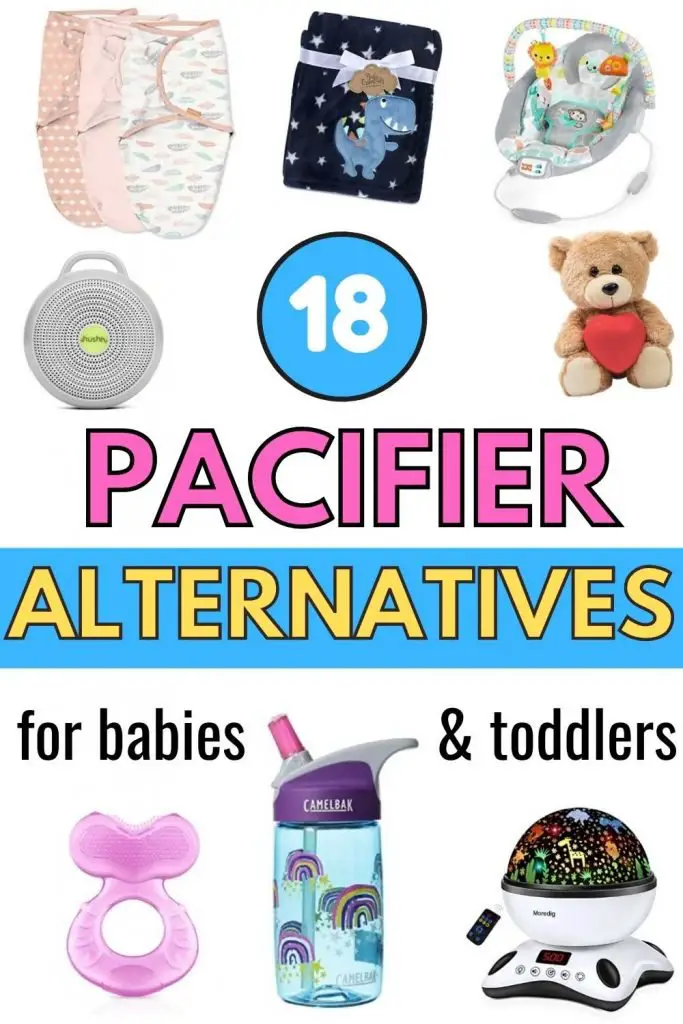
Pros and Cons of Pacifiers
Before I go through my list of pacifier alternatives, I’d just like you to go through these pros and cons of pacifiers. And I’d like you to understand the circumstances under which it could be a good or a bad idea for your baby to suck on one.
I find there are so many parents who want to avoid using the pacifiers just because they think it’s not good for their baby when, in some situation, a pacifier can actually be a saving grace.
Advantages of Pacifiers
Comfort
A pacifier can offer comfort when a baby is crying or being very fussy, as the sucking helps babies soothe themselves.
Pain relief
As per the above, because the suckling action can help babies calm and soothe themselves, a pacifier can also help them cope with pain and discomfort, such as teething or when receiving a vaccination.
Sleep
Because the sucking comforts them, a pacifier can really help your baby fall asleep (or back to sleep!). This can come in quite handy when trying to remove breastfeeding as a sleep association during sleep training!
Related: 6 Sleep Training Methods that Actually Work (and don’t involve Cry It Out!)
Reduced risk of SIDS (sudden infant death syndrome).
The American Academy of Pediatrics actually encourages the use of a pacifier when putting baby down to sleep to help reduce the risk of SIDS.
Helps preterm babies
Studies have found that non-nutritive sucking, such as the use of a pacifier, can significantly decrease the length of hospital stay in preterm infants and can help with the transition from tube to bottle feeding.
Helps mothers with PPD with breastfeeding
According to a study fro the Journal of Human Lactation, vulnerable moms that are at high risk of postpartum depression (PPD) do better with breastfeeding it their baby uses a pacifier. The self-soothing action of the pacifier gives mom a little more time between feedings, reducing stress.
Easier to stop than thumb sucking
Many parents (and the American Academy of Pediatric Dentistry) report that it’s easier to break the habit of sucking on a pacifier than it is to stop children from sucking on their thumb (or other fingers), as these are not part of baby’s body.
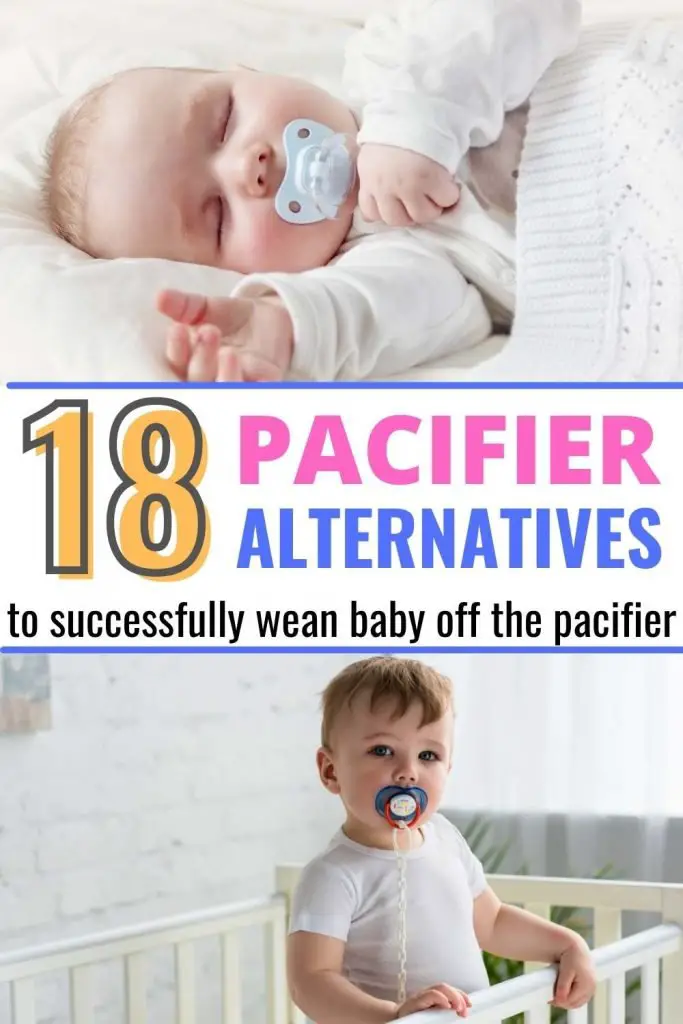
Disadvantages of Pacifiers
Interference with breastfeeding.
Introducing a pacifier before you’ve got the hang of breastfeeding (usually when your baby is 3-4 weeks old) can negatively affect your ability to breastfeed. This is because the sucking on a pacifier is different to the sucking for breastfeeding, and this can get your baby confused (also called “nipple confusion”). However, it’s perfectly safe to introduce a pacifier from around 4 weeks old!
Dental Problems
Using a pacifier long-term can affect the shape of the teeth and mouth, causing problems such as an overbite or cross bit. This is especially true for children over 2 still using a pacifier. The American Academy of Pediatric Dentistry (AAPD) recommends weaning from the pacifier from age 3 the latest.
Ear Infections
Studies have found that children who do not use a pacifier continuously have one-third fewer ear infection episodes than children who do.
Speech delays
According to some speech-language pathologists, extended pacifier use may cause speech delays by limiting the child’s opportunities to talk. That said, there is no clear evidence from research that this is the case. My first daughter who used the pacifier until she was 2 had no speech delays.
Dependence
Pacifiers easily become addictive to babies and toddlers and, if you start it, it’s hard stop. Plus, babies who are dependent on a pacifier don’t like to lose it, which means lots of crying when they lose it at night or during the day.
Why you should Wean Off the Pacifier
With all of the above in mind, you can now make an informed decision on whether you want your child to use a pacifier or not and, if they already are, whether it’s actually time to wean them off it or not.
In general, reasons why you would want to wean your baby or toddler off the pacifier are the following:
- You have just given birth and want to breastfeed, but noticed that baby is struggling to feed at the breast.
- Your baby is over 2 years old and you are starting to get worried about possible dental problems.
- Your baby has become very dependent on the pacifier, and you spend hours putting the pacifier back into their mouth after them lose it.
The last two reasons are the ones that applied to both my daughters. The last one in particular was driving me insane!
When you should Ditch the Pacifier
Now the big question: WHEN should you stop giving the pacifier to your child?
Well, I think that really depends on you (and how determined you are to stop your child’s habit) and on your child’s temperament. For babies or toddlers that are very dependent on their pacifier it can be real hard to wean them off: we tried with our first child when she was just over one but we found it to be too hard at the time. So, we decided to wait until she was a bit older and able to process the news that the pacifier was going to disappear better.
On the hand, if your baby is still quite little and not too attached to it, it might be easier to wean them off as soon as possible. I found it relatively easy to wean my second daughter off the pacifier when she was 4 months old.
Either way, to avoid any dental problems, you do want to say bye-bye to the pacifier by no later than the third birthday.
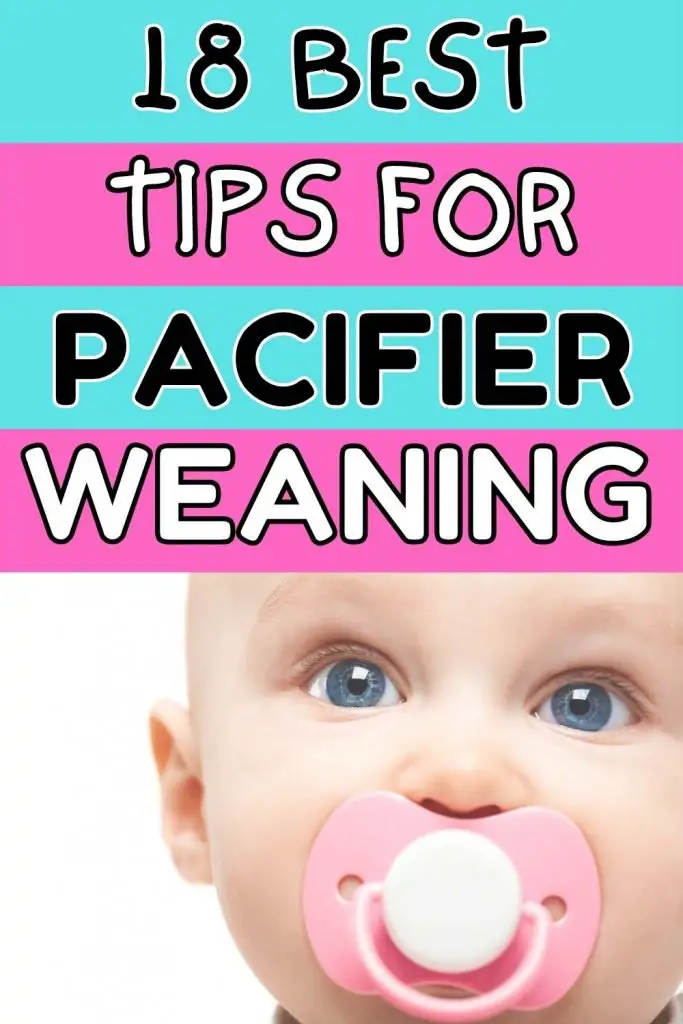
Pacifier Alternatives for Babies and Toddlers
Without further ado, here’s a list of 18 pacifier alternatives for babies and toddlers.
I have split them up in two different categories: pacifier alternatives for babies (newborns and infants, up to 1 year old), and pacifier alternatives for toddlers (over 1 year old). The reason for this is that newborns and infants have different comfort needs compared to older toddlers, and will react better to different soothing alternatives.
Pacifier Alternatives for Newborns and Infants
Newborns and infants – let me just call them “babies” (under 1 year old) – love sucking on a pacifier because of the following reasons:
Soothing / Comforting
Sucking on pacifiers reminds babies of being in the womb, which triggers a baby’s innate calming reflex. It lowers their heart rate, blood pressure and stress levels.
Pain Relief
Like I mentioned above, because the suckling action can help babies calm and soothe themselves, a pacifier can also help them cope with pain and discomfort, such as teething or receiving a vaccination.
Understanding these reasons will probably make it clearer as to why the following pacifier substitutes could work when trying to wean your baby off the pacifier. As long as you can give your baby that sense of comfort and security to calm them down and relieve some of the pain, then you will succeed.
1) Breastfeeding
If you are breastfeeding, then this is definitely your number one alternative to soothe your baby! Whether they are crying because they are in discomfort, or because they are tired (and not necessarily hungry), the boobs almost never fail.
There’s always this strong association between breastfeeding and nursing, but moms often forget that offering their breasts to their child doesn’t just need to be for nursing purposes. Using breastfeeding for comfort is actually called “comfort nursing”.
The one thing to be aware with breastfeeding is that you will find yourself feeding quite a lot! I have seen friends constantly taking their breasts out to feed so they could comfort their child and, whilst I appreciate this works for some moms, I don’t think it could have ever worked for me.
The other thing to be aware of is that breastfeeding can easily become a very strong sleep association, meaning your baby won’t be able to fall asleep unless they suck on your breasts. If that is the case, you will probably start noticing it towards the 4 months old mark, when you go through the nightmare of the so called 4 month sleep regression.
To teach your baby how to fall asleep independently without falling asleep at your breasts, you can have a look at these gentle sleep training methods (that do not involve Cry-It-Out).
Related:
- Baby Waking Up Multiple Times a Night – here’s what you need to know
- 4 Month Sleep Regression: why it is the most important one to get right!
2) Swaddling / Sleeping Bag
Swaddling your baby has many benefits, amongst which is the fact that it recreates the secure and cozy feeling of the womb, giving the baby a sense of comfort, warmth and security. So, using a swaddle can also be a good pacifier alternative.
If you are swaddling, just make sure to stop as soon as your baby starts rolling, so that their arms can be free.
Check out these swaddles from SwaddleMe, with a very convenient velcro and zip at the bottom for easy diaper changes. Or, if you have a baby girl, have a look at this list of best baby girl blankets, including swaddles.

However, know that every child is different and not all children like to be swaddled! My daughters, for example, never liked to be swaddled (other than the first few days after birth), so I just put them to sleep with a blanket and then in a sleeping bag.
A sleeping bag is also another great solution, still giving a sense of comfort and security to your child. And you can keep using it until your child is ready to use a blanket / duvet (around 2 years old).
Related:
- How to Dress Baby for Sleep
- 8 Best Baby Sleeping Bags for Winter (2.5 & 3.5 TOG)
- 10 Best Baby Sleeping Bags for Summer (0.5 & 1 TOG)
If your baby doesn’ like the swaddle and you don’t feel comfortable putting them to sleep in a sleeping bag, then check out the Love to Dream Swaddle UP. This hybrid between a swaddle and a sleeping bag has two wings that allow babies to sleep in their natural arms up position, instead of restricting their arms movement down. This way they can self-soothe by touching their face and sucking on their hands, just like they did in the womb.

3) Rocking / Bouncing
Rocking or bouncing your baby is another great alternative to soothe baby. What baby doesn’t like to be bounced around?!
I have memories of spending so much time in the evening walking round and round the lounge while rocking my daughters so they would fall asleep in the evening. Apparently, it’s another of those reminders from when babies were in the womb and used to be jiggled around in mama’s belly.
Just make sure you are always supporting the head and neck 🙂
If you are still planning your nursery, I would recommend looking at a rocking chair, so that you can keep the rocking going even when you are too tired to stand up and walk (though stopping the walking doesn’t always work! lol).

Similarly to breastfeeding, careful that this doesn’t become a new sleep association, where your baby can only fall asleep if they are rocked to sleep. If that is the case, do have a look at these gentle sleep training methods that will teach your child to fall asleep independently.
I personally started rocking my second daughter to sleep when I wanted to wean her off the pacifier. It was either that or she would fall asleep while breastfeeding. I found this to be an easy transition to help her fall asleep without a pacifier. Teaching her to fall asleep by herself was the next step and that took a bit more time and sleep training!
4) White Noise
A white noise machine can be unbelievably amazing at settling your crying baby and therefore can be a very good and clever substitute for pacifiers. I did not believe in the power of white noise at settling babies until I witnessed my first daughter falling asleep within seconds by listening to the noise of a vacuum cleaner on YouTube!
Now, running an 8 hours YouTube video with a noise of a vacuum cleaner might not be an option at night (though there are videos that long, I swear!), so I would really recommend buying a white noise machine. And, if you can, buy a portable one that you can hook on a stroller or car seat and take with you when you are out an about.
I used the Hushh Portable White Noise Machine with my second daughter and it was one the best investments I ever made.

If you can’t buy a white noise machine or don’t have access to YouTube, just turn the hair drier or the vacuum cleaner on at home when baby is upset and see what happens 🙂
5) Baby Swing / Bouncer
I honestly couldn’t have survived the first few months after my daughters’ births without a baby swing (we call it bouncer). This is literally a must-have, and I bet most of you reading this article already have one, or are thinking about getting one.
The concept is the same as the rocking and bouncing: your baby will be soothed by the swinging motion, and you’ll actually get a chance to put your baby down for a while and stop walking around.
We’ve had quite a few nights watching television while rocking the baby swing with my hand or foot to keep it moving so baby wouldn’t wake up.
Most baby swings come with music, though I never found the music to be really helpful at calming my babies. What seemed to help instead was the vibration! I highly recommend getting one with the vibration included, like the Graco Soothe N' Sway.

There are also options of baby swings that swing automatically at the press of a button, such as No products found.. But, whichever you choose, make sure there is a newborn insert, as they can be pretty hard to use with newborns otherwise!
6) Finger
A finger (usually the thumb, but not always!) can be a great alternative to a pacifier for both babies and toddlers. My second daughter learned to suck her fingers (index and middle fingers) when I weaned her off the pacifier and I am so glad she did!
The only downside to the fingers is that getting your child to stop sucking their finger(s) can actually be harder then getting them to stop using a pacifier. Do it at your own risk ….
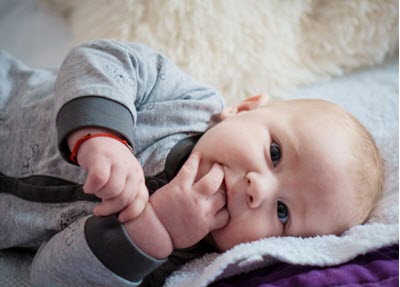
For newborns it can be pretty hard to learn how to suck their finger, so an alternative is to offer your finger (the little pinky usually works). This is a pacifier alternative that nobody usually talks about, and the only reason I found out it works was because we had to use our finger to get our first daughter to take milk from a syringe when she was born: it helped stimulate her sucking reflex.
I never used it for too long or too often: it was just to quickly settle my second daughter in particular if she was crying. And I only did it for the first couple of months of her life. But, I can tell you, I had so many people frown at me when they saw me doing it!
That said, my motto is “do what works for you”, and this worked soooo well for me!
7) Teething Toy
Teething must not be fun for your baby at all. My wife always jokes saying that there’s a reason why we don’t remember how painful teething was: it was so bad we removed it from our memory!
When babies are teething and in discomfort, they need extra soothing, and a teething toy can offer that instead of a pacifier. Not to mention that babies love to put everything in their mouth to explore the world!
As a preference, make sure to pick teething toys that are made of natural materials, such as wood or silicone: avoid plastic toys! Nuby’s products, including the Nuby Silicone Teethe-eez Teether, are all very good quality and highly recommended.

There are also teething toys that can be frozen (the cold helps with the soothing), such as the Nuby Ice Gel Teether Keys, or that you can add frozen breastmilk or other liquids to, like the Teetherpop Freezable Teether.
8) Car
When all else fails, the car almost never fails to disappoint at soothing babies. I have met so many moms that used to drive around the block just to get their child to sleep.
I found that even the car seat was comforting for my second daughter when she was very little, without the need to drive the car. So, I had times when I put her into the capsule and swung her in the lounge 🙂
9) Walks
If you prefer a walk to a drive, also go for a walk with the stroller or with a baby carrier. Both my daughters use to love being carried in a carrier or wrap, so I often went for walks outside (or even inside!).
When my first daughter was 2 years old, I also fell in love with my hip seat baby carrier, and got one for my second daughter for when she was around 4 months old. They don’t hurt your shoulders or back so much like traditional carriers, and they can transition to just a hip seat when baby is older.
These carriers or wraps are actually an essential for your newborn baby checklist if you are still expecting! Once they are in it they’ll soon forget about the pacifier.
Related:
Pacifier Alternatives for Toddlers
What can you use instead of a pacifier for toddlers? Well, with toddlers it can be a bit trickier to wean them off the pacifier, mainly because after 1 year old kids are way more aware of what’s happening and start to have a very good understanding of what’s “theirs”. Yet, they’re not old enough to have a conversation about it and understand why they need to let go of their favorite soothing item.
While they still want the pacifier for comfort and possibly a bit of pain relief when teething, it’s usually just become a habit for them by this stage. However, there’s a few things that you can try, and most of them involve swapping the pacifier with another item that they can get attached to.
Here’s how to break a toddler from a pacifier.
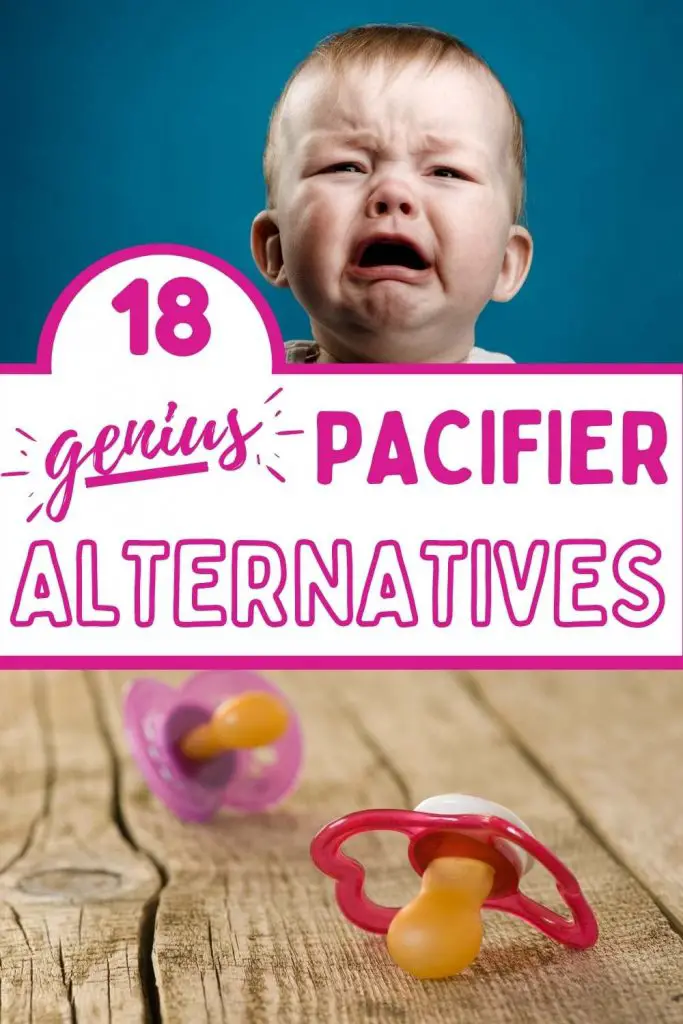
10) Night Light / Projector
A night light or a projector can make wonders at making your toddler feel safer at night sleeping in their room. It can also give them something to direct their attention to, instead of the pacifier.
In fact, distractions when toddlers cry for their pacifier can be very effective!
It might work even better if you involve your child in the decision of which light or projector to buy for their room.
We had a night light with a shape of a deer when my first daughter was little and that worked very well: she wouldn’t sleep without it and we took it everywhere with us for holidays. Once she got a bit older, we were gifted a night light with words on it and a very cute pattern, and she was always very fascinated with the letters and the stars on it.
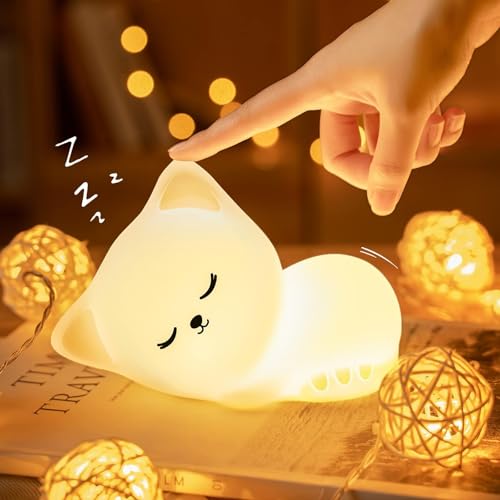
One thing to be aware of with a projector is be careful that it doesn’t over-stimulate your child before going to bed. You want a good distraction from the pacifier, but you also don’t want a toddler that doesn’t want to fall asleep! I would personally try just a light first and, if that doesn’t work, try a cool projector.

Also, think carefully about how you want to use the light or projector. Stand-alone lights can be very handy because they are usually small and you can take them anywhere (even camping, for example), without worrying about plugging it in. However, if you leave it on the whole night, the batteries don’t last that long.
We had to change my daughter’s light almost every two months because, as the batteries started to dies, the light was not strong enough anymore to satisfy my daughter’s needs.
Lights that need to be plugged in at the wall, on the other hand, don’t have that problem. But you are limited as to where you can take it with you.
11) Soft Toy / Teddy
A soft toy / lovey or a teddy is definitely something you can try to wean off your toddler from the pacifier. It’s quite common knowledge that most kids have a favorite teddy that they like to cuddle in bed and fall asleep with.
And I bet you have hundreds of soft toys or stuffed animals around the house that people gifted to your child … for some reason it seems to be the thing that people love to gift the most!
Show them to your toddler and see if they show any preference for one. Whichever they choose, start placing it in bed with them at night, and take it out for adventures together. Also offer it to your child when they get upset.
Soon they’ll start associating the lovey to a new sense of comfort and will want to take it everywhere with them. Beware though, once they get attached to the blanket, you won’t be able to go anywhere without it anymore!
My daughter got so attached to a soft toy that now we must be very careful never to leave it behind, or it’s going to be tears! Still better than having the pacifier, but not ideal ….
For older kids you can also try to have a conversation and propose a swap: the pacifier in exchange for a new soft toy. The idea of getting a new cuddle buddy might get them excited enough that they’ll agree to it.
12) Blanket
Blankets, similarly to a soft toy, can give a very strong sense of security to children, therefore can be another great alternative to the pacifier. Remember Charlie Brown’s blanket? 🙂
To introduce the idea of a blanket to your kid, start by placing it with your kid (particularly at nighttime when reading books or going to bed) as much as possible and offer it to them when they are upset.
Once they start associating the blanket with a new sense of security, that’s when you can attempt removing the pacifier. Again, same as with the soft toy, be mindful that once they get attached to the blanket, you won’t be able to go anywhere without it anymore.
If you have a baby girl, also check out this list of baby girl blankets for some ideas on what the best products are depending on your climate and the materials of the blanket.
https://www.pinterest.nz/pin/109212359684045968/13) Bottle / Drink
Another idea is to offer your toddler a drink with a bottle instead of the pacifier when they get upset or wake up at night. Using a bottle with a straw, or one that’s not a feeding bottle anyway, is preferable, as it gets your toddler used to a different type of sucking.
This will help with weaning from breastfeeding or bottle feeding as well.
If you are still feeding, adding milk or formula to the bottle can be a good idea to start with, but I would gradually swap that with water as you start weaning your toddler off breast milk or formula.
A good tip is to have spill-proof bottle (even with a straw) on the cot or by the bed, so that your toddler can reach it at night by himself. We use CamelBak water bottles for our kids and would totally recommend them to anyone!

14) Weaning Pacifier
Also try giving a weaning pacifier a go! This is such an amazing idea: it is a modification of a regular pacifier, where a hole is placed in the nipple so it can’t be sucked well and therefore rendering the pacifier unsatisfying for the child.
While the idea is great though, not all kids that try it also enjoy it! Some kids just keep screaming for the old one, others get attached to it like they used to be attached to the previous one.
Still worth giving it a try, but don’t have very high expectations. The big pro if it works is that than you would have removed the pacifier without creating a new strong attachment (to a soft toy or a blanket for example).
No products found.No products found.
15) Break the Suction Power
This is pretty much the DIY version of the pacifier alternative listed above, so can be perfect if you want to give it a go but don’t want to spend money for the weaning pacifier.
To break the suction power, just make an incision in the pacifier teat. Be prepared for tears though and, if it doesn’t work, know you can’t go back to the original (unless you buy a new one!).
16) A New Toy
Similarly to the lovey or soft toy, a new toy is another option to try when wanting to wean your toddler off the pacifier. This might work particularly well with older kids (closer to 2 years old), who get excited at the idea of choosing a new toy and could trade the pacifier in for it.
A one year old toddler might still be too young to fall into this trap 🙂
For it to work, make it a big thing: get your child excited about getting a new favorite toy, take them to the store so they can pick it up themselves and praise them for the good choice.
17) Sleeping Bag
Like I mentioned above for babies, a swaddle can be a great pacifier solution by soothing a newborn or infant. However, once babies start to roll, you will need to replace the swaddle with something else.
A sleeping bag is such a great idea, and one that I have used successfully with both my kids for years. It gives a sense of comfort and security to your child and you can keep using it until they are ready to transition to a blanket / duvet (around 2 years old).
Related:
– 8 Best Baby Sleeping Bags for Winter (2.5 & 3.5 TOG)
– 10 Best Baby Sleeping Bags for Summer (0.5 & 1 TOG)
18) Doll with Hair
I absolutely had to add this because it totally worked with my second daughter. In fact, what I soon discovered with her is that so many little kids love to twirl / pull their hair while sucking their fingers.
According to Kids+ Pediatrics, hair-twirling can be a self-soothing activity that your toddler may engage in during times of stress, boredom, or (most commonly) before bedtime to help wind down.
And they don’t just like to do it with their hair! I used to get so frustrated when picking my daughter up or trying to co-sleep with her and she would start pulling my hair by default. So, one day I bought her a doll with hair, hoping she would start doing that to the doll instead of me … and it worked!
She now loves her doll when she’s asleep and, if she wakes up, she just picks it up and falls back to sleep while twirling its hair.
If your child also likes to twirl his/her hair, definitely give this a go!

Pacifier Alternatives for Babies and Toddlers: Final Thoughts
That’s it for my 18 pacifier alternatives for babies and toddlers. I really hope you found this list useful and I am confident that at least one of these tips will work with your child!
If I can give a last piece of advice is this: whatever you do, do not go back! Once you’ve made the decision to make the pacifier disappear, do not give it back to your child. Hold on for a few days if there’s tears and your baby’s upset, and you’ll seen that they’ll soon forget and learn to find comfort in something new.
Remember it’s also time to think outside the box: every child is unique and you might find an alternative that works for your kid that’s not listed here. Like a doll worked for my daughter, something else might work for yours.
And if you prefer to go cold turkey in the end, that’s also an option. We had to do that with my daughter eventually to get rid of the pacifier at night. It took couple of days, but then she accepted the new reality.
My mom always likes to remind me of how she convinced me that I was not going to receive my Christmas presents unless I left my pacifier to Santa. She even helped me wrap it in a nice box and we left it under the Christmas tree. But when the night came and when it was time to go to bed I really wanted it back. I even screamed “I don’t care about the presents, I just want my pacifier back!”. She didn’t give in obviously …. and I survived 🙂
If you are struggling with your baby’s sleep and/or weaning, don’t forget to also check out these articles:
- How to Stop Breastfeeding a 1 Year Old at Night
- 6 Sleep Training Methods that ACTUALLY work (and that don’t involve Cry It Out!)
- Baby Waking Up Multiple Times a Night: here’s what you need to know
If you have a little one and need some help with feeding or survive mom life in general, then have a look at these:
- 25 Formula Feeding Tips (All Hacks to Nail Bottle Feeding!)
- Paced Bottle Feeding (Benefits and Tips on How to do it right)
- 20+ Best Online Breastfeeding Courses of 2021 (FREE Classes too!)
- How to Survive the First 3 Months with a Newborn
- 18 Tips on How to Soothe a Crying Baby
Did you try any of the pacifier alternatives for babies and toddlers listed above and have some feedback or would love to share your story? Or did you try another one not listed here? Then please let me know in the comments below, I’d love to hear from you!
Did you find this helpful? Pin It!
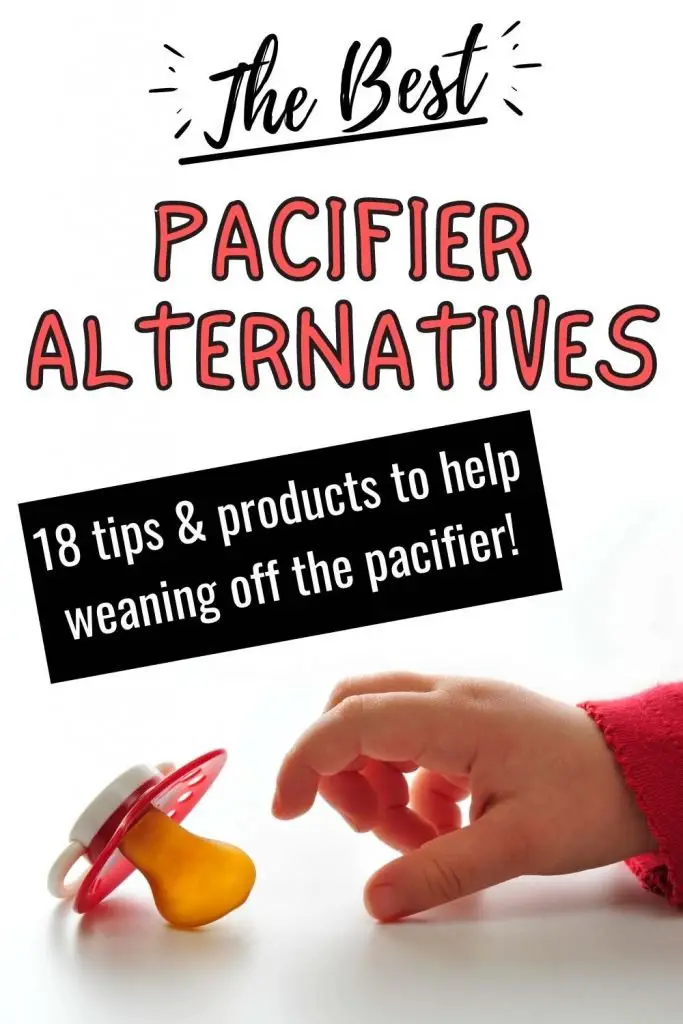


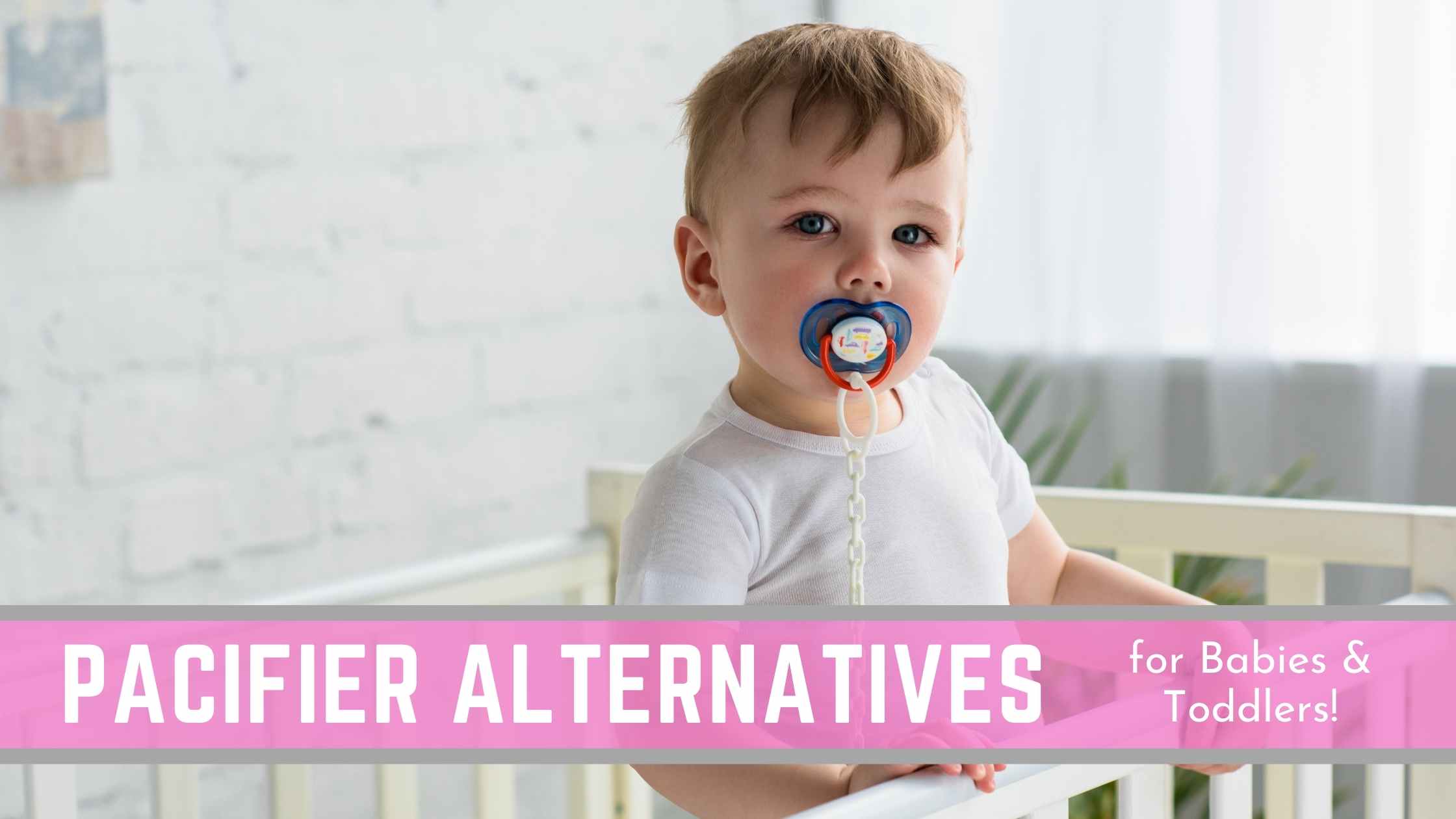
Good tips! With our first it was so hard to get rid of the soother. We did it at 18 months and although it was tough for a few days it was so nice once she we got rid of it!
Thanks Erica! Totally agree, it’s so nice once you finally get rid of it!!
So much information! I really needed this , thank you ! It answered so many questions and explained actually a lot of issues my 3 year old has now . Thank for the weaning tips , I’ll need that very very soon ! I appreciate it ! A great read!